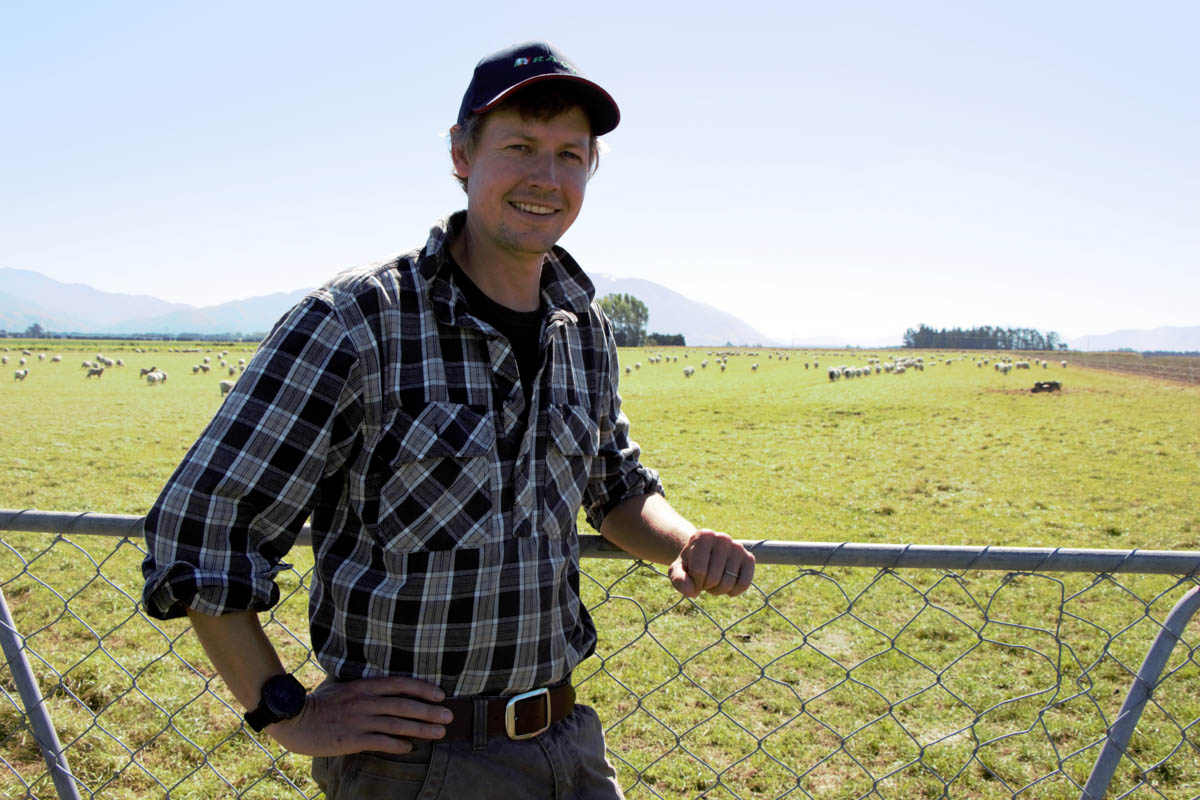Innovation is the name of the game at the giant agricultural machinery show Agritechnica 2019 in Hanover, Germany. Nick Fone reports.
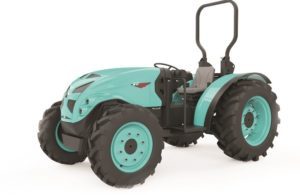 Probably the most significant development on display at the show, the Proxecto hybrid agri vehicle (HAV) was tucked away in a tiny booth in a hall full of nondescript kit.
Probably the most significant development on display at the show, the Proxecto hybrid agri vehicle (HAV) was tucked away in a tiny booth in a hall full of nondescript kit.
With its bug-eye lights and turquoise colour-scheme, you’d be forgiven for thinking it looks much like any other small tractor from the emerging markets of Southeast Asia and the Indian sub-continent – there were many spread through the Hanover exhibition halls.
But nothing about the HAV is conventional. It has no clutch, no gearbox, no transmission and no axles. The only regular thing about it is the 40hp internal combustion engine under the hood but even that can be diesel or natural gas powered.
Either way the Yanmar block powers a 40kVA generator. This provides electrical power for the wheels, PTO and any implements. Ground drive is provided by a 12hp electric motor contained within each hub. Enclosed alongside each one is a hydraulic pump that provides an oil supply for the steering and suspension on each corner.
Not constrained by conventional tractor design has given the Indian engineering team the opportunity to exploit opportunities that wouldn’t be possible with a mechanical driveline.
Without axles, the hubs are connected to the body of the tractor via elongated kingpins. That’s enabled the company to add four-wheel steering and, by integrating hydraulic rams into the kingpins, each wheel gets simple hydro-pneumatic suspension.
Integrated into the big alternator/generator is a separate hydraulic power pack. This provides oil flow for the linkage and external hydraulics. When it comes to the PTO buyers can either opt to have a beefy electric motor in the usual place you’d expect it or have it mounted on the implement itself, supplied via a socket on the rear of the tractor.
Once the working day is done, the tractor can be parked up and used as a standalone genset.
It’s also hoped that it could significantly help to reduce energy usage in farming. Because the engine is not powering a direct mechanical driveline, running through the alternator instead, the loading is much more stable. With different operating modes selected via the weatherproof touchscreen, sensors in the wheel motors and electric PTO motor detect power requirements and alter engine speed to increase or reduce electrical output as required.
The company says this leads to up to a 30% reduction in diesel consumption. Switch to a CNG-fuelled motor and the saving could be as much as 50-60%. Without torque peaks, this steadier loading is kinder on the engine with the result that service intervals could be extended beyond 1000-hours.
According to the Indian team behind the concept it’s also a relatively simple engineering job to switch the gas or diesel engine for a battery power pack should a straight electric version be required.
The critical thing about all of this is the company’s realistic approach to pricing. It acknowledges that if this technology is to make it into the mainstream then it has to be priced competitively. To that end it has simplified the design and kept production in-house wherever possible.
In India a conventional 40hp tractor will set you back $NZ20,000-$NZ23,500. Proxecto has managed to keep costs under $NZ22,000 for its diesel-fuelled HAV 50 S1, the CNG-powered S2 version coming in slightly more expensive.
FarmDroid seed’n’weed robot
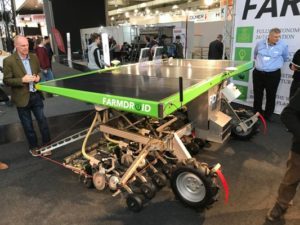 Unlike many of the autonomous bits of kit at the show, the FarmDroid is a commercial reality that’s actually in production. Developed by Danish farming brothers Jens and Kristian Warming, 12 of these autonomous seed’n’weed robots are out working in the field.
Unlike many of the autonomous bits of kit at the show, the FarmDroid is a commercial reality that’s actually in production. Developed by Danish farming brothers Jens and Kristian Warming, 12 of these autonomous seed’n’weed robots are out working in the field.
It combines two machines in one. In its primary role it’s a precision drill capable of planting row crops such as beet, etc. Once that job is done, it returns two to three weeks later and starts to hoe, both between the rows and in between the plants. Unlike all the fancy ‘konzept’ machines at the show designed to do similar jobs, it’s very simple in the way it works.
Rather than using banks of sensors to detect which are crop plants and which are weeds, it simply uses a GPS feed to record where it places the seeds and then on its subsequent weeding passes (every one to two weeks) it shoots out a blade between each growing plant to keep the area in between weed-free.
The big solar ‘wing’ provides the power with two small batteries providing back-up. The company says it will generally keep running for 22 hours a day mid growing season but if there’s not enough daylight to make that possible it can simply be plugged into the mains for a charge. They suggest it’s possible for each unit to plant and look after about 40ha of crop.
At $NZ109,000, at first glance it seems pricey but when you factor in the fact you have no labour or fuel costs and realistically the capital cost can be spread over 10 years, it actually begins to look pretty sensible.
The company is working on a version for larger seed crops such as maize and is looking into the options for targeted fertiliser placement and a possible spot-sprayer. Watch this space…
Yanmar autonomous tractor
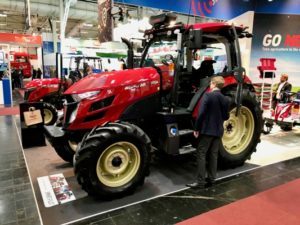 Japanese tractor and engine maker Yanmar has adapted one of its conventional tractors to work under its own steam. The snappily titled 113hp YT5113A is equipped with SmartPilot – a telematics-linked system developed in house that uses a combination of laser sensors and GPS to enable the machine to work either completely autonomously or paired with another manned tractor in a master-and-slave arrangement.
Japanese tractor and engine maker Yanmar has adapted one of its conventional tractors to work under its own steam. The snappily titled 113hp YT5113A is equipped with SmartPilot – a telematics-linked system developed in house that uses a combination of laser sensors and GPS to enable the machine to work either completely autonomously or paired with another manned tractor in a master-and-slave arrangement.
More than 100 units are out working in rice-paddies across Japan. It’s in full factory production, this is no concept. Available in Europe for the princely sum of €120,000 ($NZ201,500), the autonomous YT5113A costs about 20% more than a standard tractor.
John Deere drones and robots

Dominating the monstrous John Deere stand was the company’s circular ‘Innovation Zone’. Focusing on technology of the future, it showcased working prototypes that may or may not make it into the mainstream in the next decade or so.
Central to this was a huge multi-rotor ‘Gigadrone’ suspended from the ceiling. Developed by German firm Volocopter, the original concept was conceived to transport people around congested urban areas. Able to airlift a 200kg payload, Deere saw the opportunity to adapt the UAV to carry a sprayer capable of making low-volume targeted applications of plant protection products.
At the other end of the spectrum, the firm had its swarm spot-sprayer concept on show. A collection of smaller drones able to carry three-litres of spray liquid and detect weed/disease areas, they work autonomously and return to the ‘hive’ to recharge and refill.
Sticking with agrochemical applications, Deere also unveiled its high-clearance autonomous sprayer. Designed for large-scale broadacre crops, the tracked machine uses petrol/electric hybrid technology borrowed from the automotive world. With a vast array of sensors and the computing power of a small office-block (thanks to the green giant’s acquisition of tech. specialist Blue River two years ago), it will apparently be capable of making its own decisions about what to apply.
Falling firmly under the artificial intelligence banner, this ‘See and Spray’ technology could see machines diagnosing pest and disease outbreaks and deciding how best to deal with them all by themselves – not good news for agronomists…
Employing a different form of hybrid technology, the fruits of Deere’s partnership with Belgian implement manufacturer Joskin should be coming to market shortly. The concept is fairly simple – a big generator mounted on the tractor flywheel provides electrical power for wheel motors on a tanker or trailer chassis, helping to propel the whole rig along in tricky conditions.
Perhaps the most difficult-to-fathom item on display was a twin-track cabless, driver-less tractor. Designed to work as part of a team of similar machines in a follow-the-leader system, the autonomous machine has two 250kW electric motors – one for ground-drive, the other for the PTO and hydraulics.
It has a complex hitch arrangement that means there’s weight transfer between the implement’s axle and tractor, effectively creating a balanced, twin-axle rig when the two are coupled together.
Continental tool-carrier robot
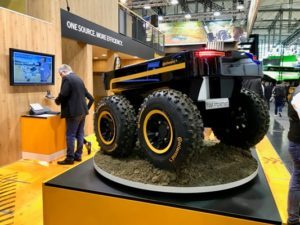 While Continental might be a name you associate with tyres, the company actually has a whole host of other strings to its bow.
While Continental might be a name you associate with tyres, the company actually has a whole host of other strings to its bow.
Rubber products account for just 40% of the business’ turnover with automotive components such as parking sensors, adaptive cruise control systems, digital displays, etc making up the lion’s share of revenue.
With this arsenal of high-tech kit on offer, the German company has taken a fresh look at how this existing technology can be redeployed into other industries including agriculture. The result is this autonomous implement carrier.
With either 2kW/hr or 3kW/hr batteries, the machine has an electric motor on each side driving the wheels, a differential providing skid-steering. In between is a central docking bay designed to accommodate a range of slot-in implements. Continental says it has no plans to develop these itself, preferring instead to work with existing equipment manufacturers to miniaturise machinery for the purpose. The theory is that a swarm of these tool-carrier robots could perform all the tasks between cultivations and harvest – seeding, spraying, weeding and making targeted fertiliser applications.

